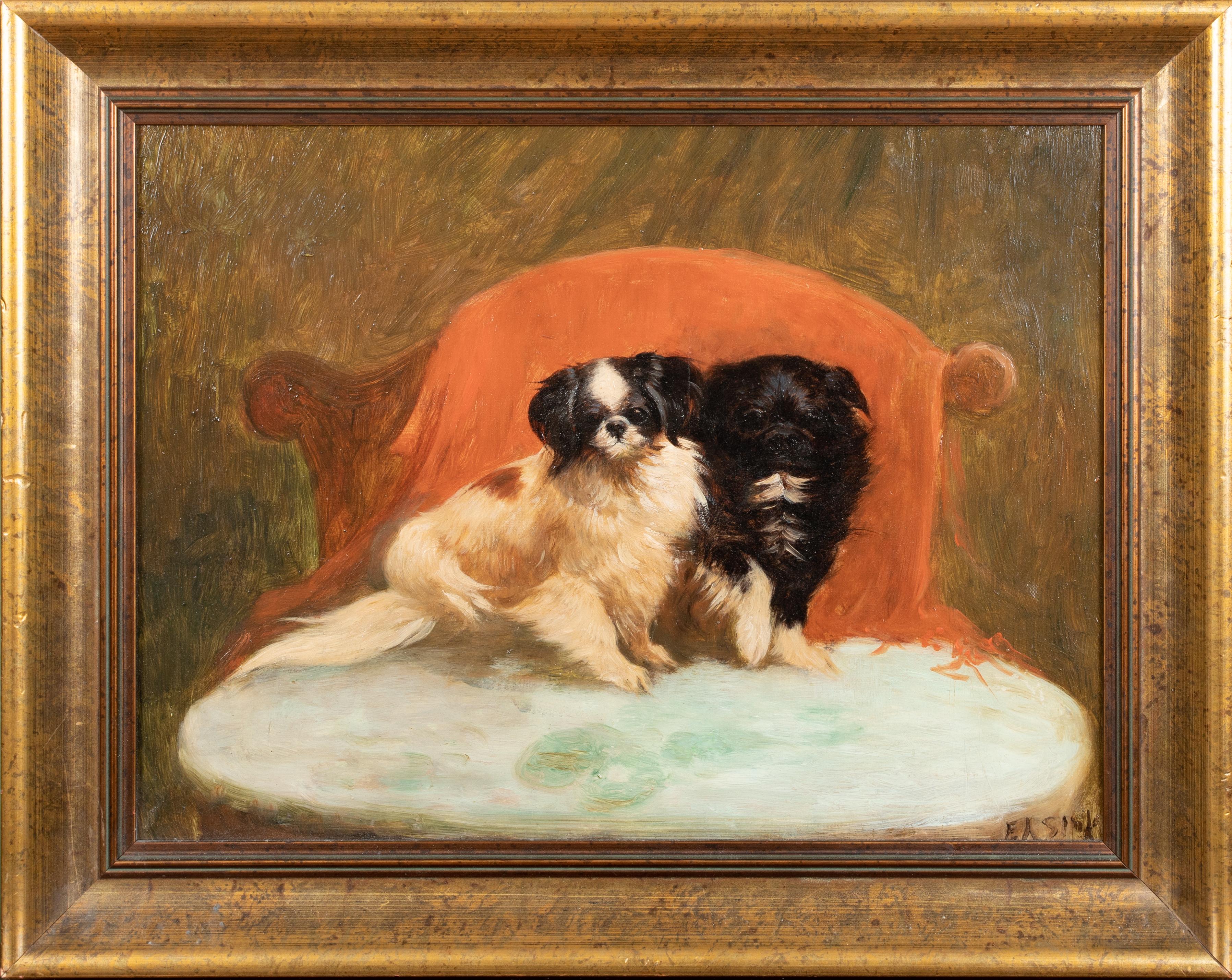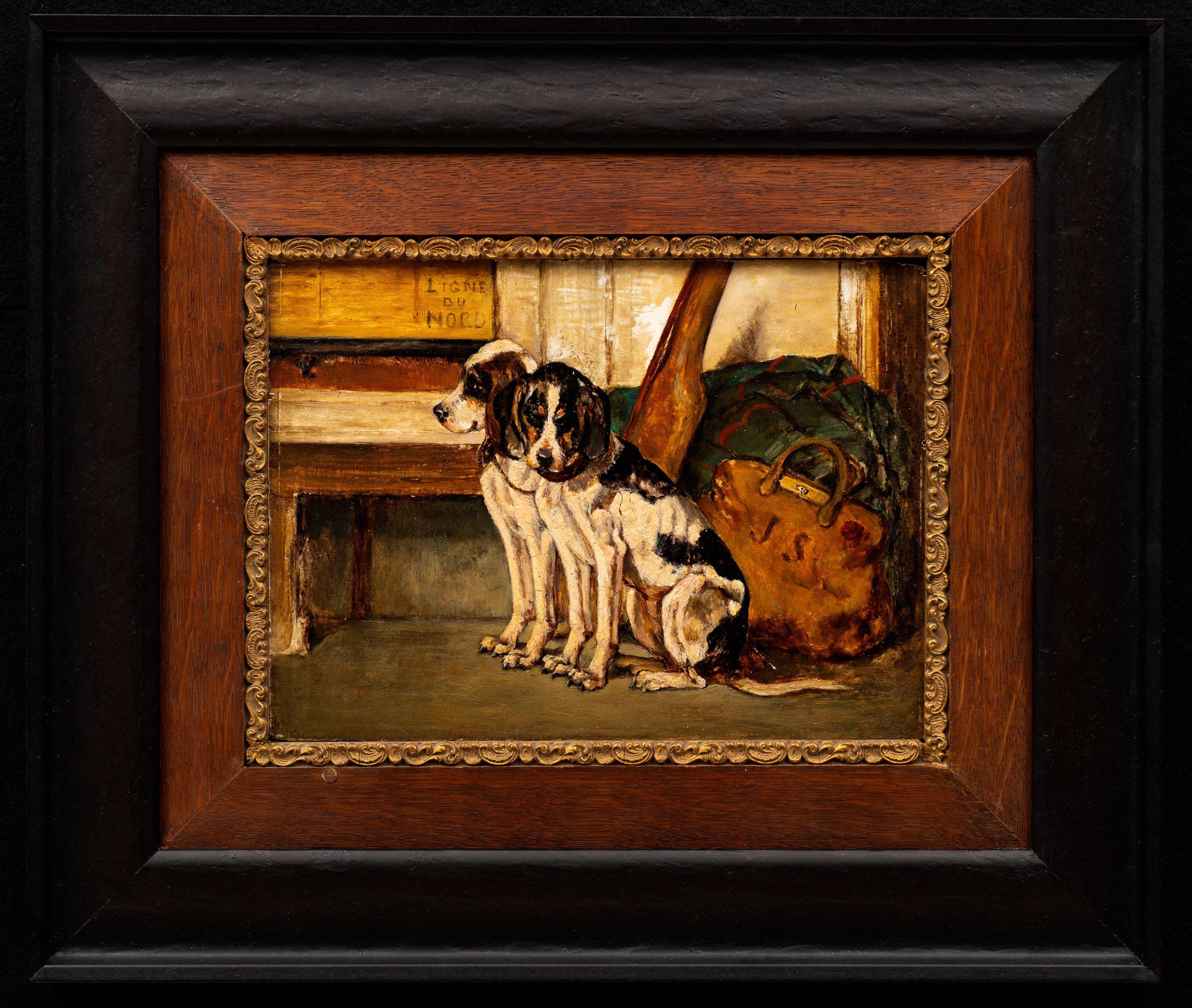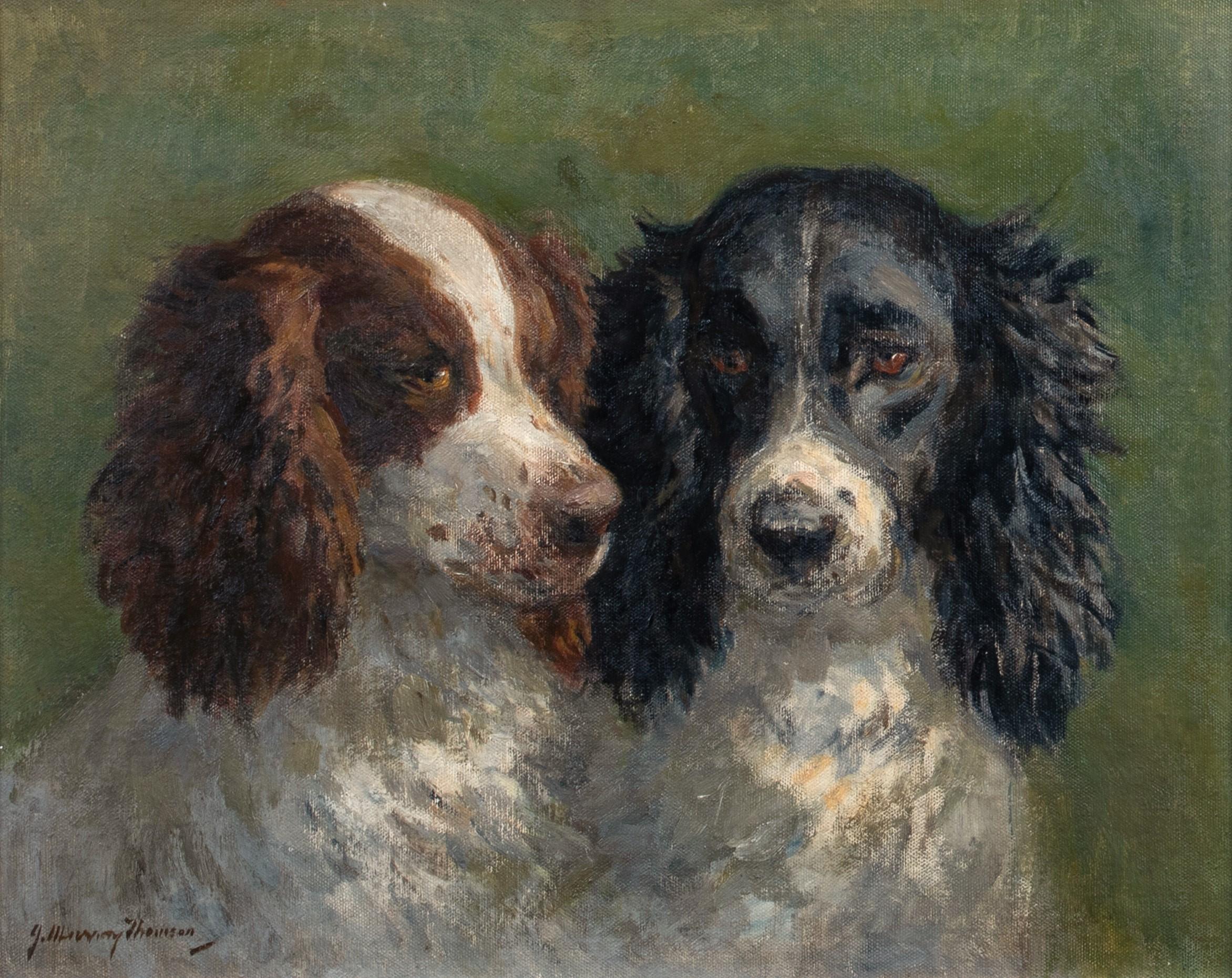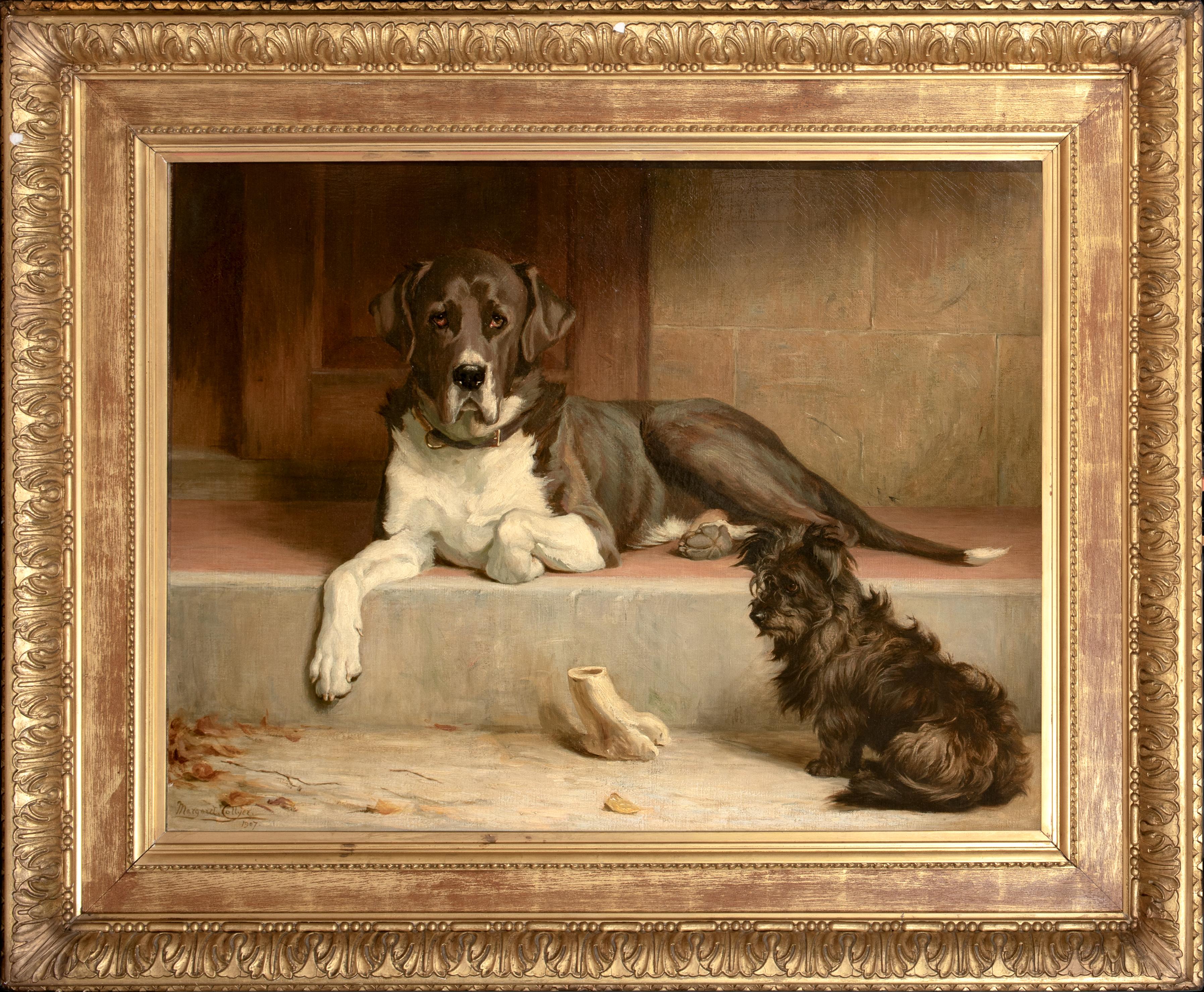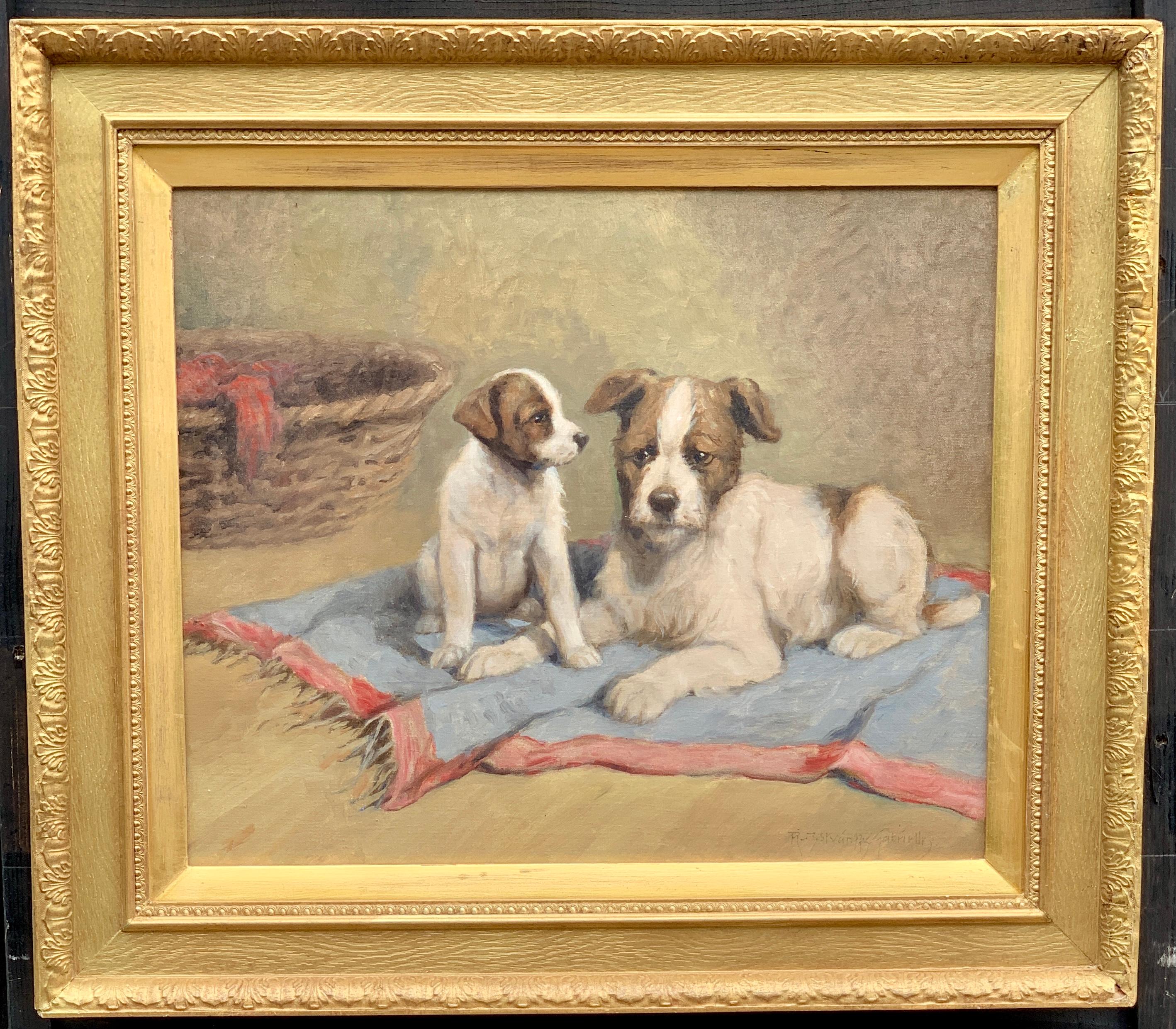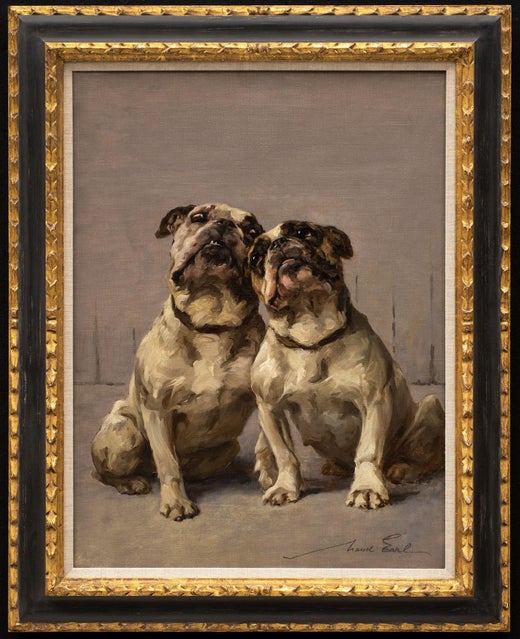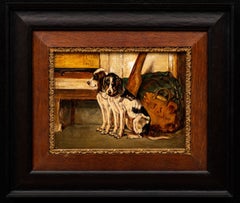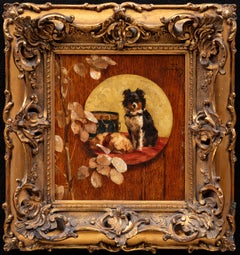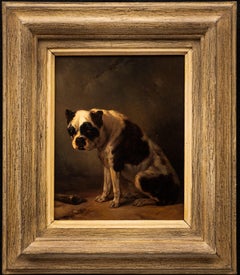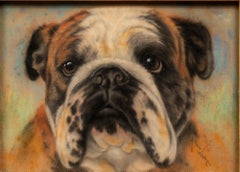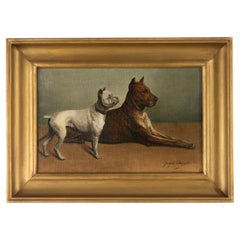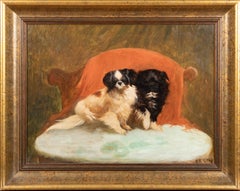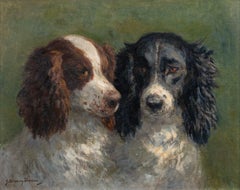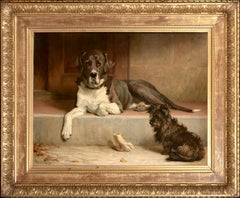Items Similar to Dog Portrait "Two Bulldogs-Best of Friends" Maud Earl (English, 1863-1943)
Video Loading
Want more images or videos?
Request additional images or videos from the seller
1 of 14
Maud EarlDog Portrait "Two Bulldogs-Best of Friends" Maud Earl (English, 1863-1943)
$34,000
£26,120.94
€30,012.66
CA$47,825.21
A$53,729.48
CHF 28,073.74
MX$655,793.46
NOK 356,454.46
SEK 335,526.78
DKK 223,965.66
About the Item
"Two Bulldogs-Best of Friends"
Maud Earl (English, 1863-1943)
Oil on canvas
Signed lower right
24 1/4 x 18 (30 x 23 1/4) inches
In the pantheon of 19th and early 20th century painters of purebred dogs, Alice Maud Earl ranks among the very best and most highly regarded dog portraitists.
Her clientele were the most prominent dog breeders and dog fanciers of the day on both sides of the Atlantic. Eventually, as her reputation grew during the 19th century in the world dog shows and pure dogs, she came to the attention of Queen Victoria and the royal family. The Queen was a great lover of dogs and dog paintings. At any one time the Queen had as many as 70 dogs at her kennels at Windsor, and the Queen's favorite artists such as Sir Edwin Landseer and Gourlay Steele depicted many of her dogs. Her patronage was not limited to her court artists, however, and Maud Earl was summoned to Windsor to paint her favorite Collie, a breed which Queen Victoria had been instrumental in popularizing.
Queen Victoria was not the only of Miss Earl's royal patrons. She had often painted dogs belonging to the Prince and Princess of Wales, Albert and Alexandra, the future King and Queen of England. Among the most famous of these canine sitters was the Borzoi Alex, belonging to the Princess, who was so admired that dog fanciers lined up on queue just to catch a glimpse of him.
Maud Earl was born in the West End of London. Maud's profession was the continuation of a family tradition. Her father George, her uncle Thomas Earl and her half-brother Percy Earl were also animal painters of note. George Earl, an avid sportsman and noted sporting painter, was his daughter’s first teacher and ensured she studied the anatomy of her subjects, drawing dog, horse and human skeletons to refine her skills. She later said that her father’s instruction had given her ability that set her apart from other dog painters. After her father's tutelage Maud went on to study at Royal Female School of Art, which was later incorporated into the Central School of Art.
Maud Earl soon came to specialize in animals, and in dogs in particular, since she had a special affinity for them. As the artist pointed out in an interview in the November 1898 issue of The Young Woman, "You can't paint dogs unless you understand them; I don't mean merely from the fancier's point of view. You must know whether they are happy and comfortable, and if not, why not. You must know how to quiet them when they become excited and nervous. You must know all their little likes and dislikes, and this knowledge comes from long experience."
Starting in 1884, Earl exhibited around twelve works at the Royal Academy starting with a stag painting Early Morning in 1884. She also exhibited at the Royal Society of British Artists and at the Paris Salon. In 1897 Earl had an exhibition in which she showed 70 paintings of 48 different breeds of dog.
According to William Secord:
“Describing how she went about painting her canine subjects, Miss Earl explained that she never used photographs, for she preferred to paint what she saw, rather than what the camera saw. Rather, she posed the canine subject on a sort of portable stool on castors, which made it easy to move about. An attendant usually accompanied the dog, but more often than not, Miss Earl was the one to settle the dog so that he might pose quietly. First, she sketched in the general anatomy of the dog with chalks, then set about to capture the animal in oils. A single portrait sitting would typically take two days, with the artist working from 10 a.m. to 4 p.m. The painting would then be completed at her leisure.”
Maud Earl's career can be said to have developed through four styles. The first, which is more typical of her work from 1880 to until about 1900, is of fully finished, rich and naturalistic paintings with a landscape or interior setting. The second distinguishable style of the figures and landscapes are painted in her earlier, highly finished style, but the perimeter of the paintings is left loose and sketchy. In the third type of painting, the background appears to have disappeared almost entirely, except for a few sketchy renderings which either establish the dog in a landscape or somehow relate to the dog's country of origin.
Upon to moving to the United States, Maud entered what she called her oriental style. During this time, she painted delicate pictures of birds and dogs, and she believed these to be some of her best works. Towards the latter part of her career, she continued to paint stylized dog portraits during the 1930s.
It seems curious that an artist so successful in England would suddenly move to America, but the onset of World War I had forever changed the world that she had known and loved. Her work had always been well received in America, and in her words, "Then came the war, and that finished everything. Before America came into the struggle, I came, here, to New York.” The new commissions came almost immediately such was her fame and renown by the time of her relocation.
Secord:
“In an interview in Country Life magazine in May of 1921, she reported that she seldom did dog portraits anymore, stating that if they were not decorative, they were not worth painting. This could certainly not be said of the bird and dog paintings which she was painting around this time, which were the epitome of elegance and decorative restraint. Proclaiming that she was working in the Chinese mode (actually, her work of this period has a closer kinship with the Japanese), she painted extraordinary panels of exotic birds, sometimes in anecdotal situations with dogs, or portraits of dogs which because of her new style were elevated to what she considered "the decorative."
Earl became famous during the Victorian Era, a time when women were not expected to make their living at painting. Nevertheless, she developed a select International clientele with her fame spreading ever wider by the publication of her images in books and print form.
Maud Earl left an extraordinary body of work as the result of painting dogs for 50 years. Maud Earl died in New York in 1943 and is buried at Sleepy Hollow Cemetery in Sleepy Hollow, New York.
Multiple sources for research, though especially the writings of William Secord.
- Creator:Maud Earl (1864-1943, British)
- Dimensions:Height: 30 in (76.2 cm)Width: 23.25 in (59.06 cm)
- Medium:
- Movement & Style:
- Period:
- Condition:
- Gallery Location:SANTA FE, NM
- Reference Number:1stDibs: LU1408216501882
Maud Earl
Known primarily for her paintings of dogs and other animals in Art Nouveau style, Maud Earl was English and came to the United States in 1916, settling in New York City. Earl studied painting with her father, George Earl, one of Britain's finest sporting and dog artists. George Earl stressed the importance of anatomy to his daughter, a knowledge that she credits to her success with painting dogs. Maud Earl became a court painter for Buckingham Palace. She did dog portraits for Queen Victoria, King Edward and many other royals. Earl also contributed illustrations for The Pointer and his Predecessors (1902) and Spaniels, Their Breaking for Sport and Filed Trials (1915).
About the Seller
5.0
Platinum Seller
Premium sellers with a 4.7+ rating and 24-hour response times
Established in 1995
1stDibs seller since 2020
119 sales on 1stDibs
Typical response time: 1 hour
- ShippingRetrieving quote...Shipping from: Santa Fe, NM
- Return Policy
Authenticity Guarantee
In the unlikely event there’s an issue with an item’s authenticity, contact us within 1 year for a full refund. DetailsMoney-Back Guarantee
If your item is not as described, is damaged in transit, or does not arrive, contact us within 7 days for a full refund. Details24-Hour Cancellation
You have a 24-hour grace period in which to reconsider your purchase, with no questions asked.Vetted Professional Sellers
Our world-class sellers must adhere to strict standards for service and quality, maintaining the integrity of our listings.Price-Match Guarantee
If you find that a seller listed the same item for a lower price elsewhere, we’ll match it.Trusted Global Delivery
Our best-in-class carrier network provides specialized shipping options worldwide, including custom delivery.More From This Seller
View AllPair of Hunting Dogs at Rest; artist unknown, French, Mid-19th century
Located in SANTA FE, NM
Pair of Hunting Dogs at Rest;
Artist unknown, French, 19th century (monogrammed "JS"
Circa 1850
10 x 7 (14 3/8 x 17 1/8 frame) inches
This is finely realized portrait of pair of h...
Category
1830s Romantic Animal Paintings
Materials
Oil, Wood Panel
Dog Portraits: "The Musicians" Charles Van den Eycken ((1859 - 1923)
By Charles H. Van den Eycken
Located in SANTA FE, NM
"The Musicians"
Charles H. Van den Eycken (Belgium, 1859 - 1923)
Oil on wood panel with highly ornate original wood, stucco and gilt frame.
Signed upper right and dated "1893.'
10 1...
Category
1890s Realist Animal Paintings
Materials
Oil, Mahogany, Wood Panel
Antique Dog Painting: "A Seated Bulldog" Wouterus Verschuur (Dutch, 1812-1874)
Located in SANTA FE, NM
A Seated Bulldog
Wouterus Verschuur (Dutch, 1812-1874)
Circa 1855
Oil on wood panel.
Signed on the back
9 3/8 x 7 3/8 (15 1/2 x 13 1/2 frame) inches.
The artist shows his complete g...
Category
1850s Romantic Animal Drawings and Watercolors
Materials
Wood Panel, Oil
"Big Ben in Garden" Portrait of a Bulldog by Arthur Wardle (England, 1864-1949)
By Arthur Wardle
Located in SANTA FE, NM
"Big Ben in Garden"
Antique Dog Portrait of a Bulldog
Arthur Wardle (England, 1864-1949)
Pastel on paper Circa 1900
13 x 9 (17 x 12) inches
Though he made his reputation with large...
Category
Early 1900s Realist Animal Paintings
Materials
Pastel
Dog Portrait of a Chihuahua- Arthur von Ferraris (Hungarian, 1856-1936)
Located in SANTA FE, NM
Dog Portrait of a Chihuahua 1896
Arthur von Ferraris (Hungarian, 1856-1936)
Signed and dated (1896) right side
Oil on cardboard
11 1/2 x 8 3/4 (17 x 14 1/4 frame) inches
Provenance: ...
Category
1890s Portrait Paintings
Materials
Oil, Cardboard
Antique Dog Lithograph Taste of Alfred De Dreux, France ca. 1870 Bulldog & Frog
By Alfred de Dreux
Located in SANTA FE, NM
Antique Dog Portrait
Lithograph in the Taste of Alfred De Dreux
Bulldog and Frog
France, circa 1870
Lithography
25 5/8 x 19 5/8 (28 x 20 frame) inches
Six lithographs of dog portr...
Category
1870s Romantic Animal Prints
Materials
Lithograph
You May Also Like
Early 20th Century Oil Painting - Joseph Delvaille - Canvas - Two Dogs in Profil
Located in Casteren, Noord-Brabant
A charming early 20th-century oil on canvas by Joseph Delvaille, signed and dated 1905, depicting two dogs in profile – a standing white terrier-type and a seated brown mastiff-type....
Category
Early 20th Century French Belle Époque Paintings
Materials
Canvas, Pine, Paint
Portrait Of A Pair Pair Of Pekingese Dogs "Jip & Randolf", circa 1900 English S
Located in Blackwater, GB
Portrait Of A Pair Pair Of Pekingese Dogs "Jip & Randolf", circa 1900
English School
19th Century English School portrait of a pair of Pekingese Dogs "Jip & Randolf", oil on canvas. Excellent quality and condition study of the dogs painted by an accomplished animal painter at the turn of the century. Presented in a good gilt frame. inscribed verso.
Provenance: Victoria Art Gallery, St Helier...
Category
19th Century Portrait Paintings
Materials
Canvas, Oil
$1,941 Sale Price
35% Off
Portrait Of "Honey & Napoleon", A Pair Of English Springer Spaniels, circa 1910
Located in Blackwater, GB
Portrait Of "Honey & Napoleon", A Pair Of English Springer Spaniels, circa 1910
by John Murray Thomson (1885-1974)
Large early 20t Century p...
Category
Early 19th Century Animal Paintings
Materials
Canvas, Oil
$2,558 Sale Price
35% Off
Anticipation, dated 1907 by Margaret H. COLLYER (1872-1945) Great Dane & Terrier
Located in Blackwater, GB
Anticipation, dated 1907
by Margaret H. COLLYER (1872-1945) sales to $30,000
Large 1907 scene of the Great Dane & Black Terrier sat on an outside step, oil on canvas by Margaret Co...
Category
Late 19th Century Still-life Paintings
Materials
Canvas, Oil
$9,706 Sale Price
35% Off
Early 20th century Hungarian portrait of a terrier dog and her puppy in oils
Located in Woodbury, CT
Gabrielle Rainer Istvanffy was a Hungarian painter of animal paintings.
Her chosen subjects were mostly dogs and cats and mostly white and off-white breeds. This piece is a very pretty and cute painting...
Category
1920s Impressionist Animal Paintings
Materials
Canvas, Oil
$3,160 Sale Price
20% Off
Free Shipping
Late 19th Century Oil Painting of Two Dogs King Charles Spaniel
Located in Casteren, Noord-Brabant
A beautiful antique painting with a scene of two dogs.
Oil on wood panel.
The painting is framed in a classic gold-coloured wooden frame.
The painting is unsigned, maker unknown.
Est...
Category
Antique 1880s French Belle Époque Paintings
Materials
Wood, Paint
More Ways To Browse
Queening Stool
Antique Human Skeleton
Antique English Bulldog
Stag Stool
19th Century Chinese Stool
Oriental Stool
Antique Castor Sets
Art Nouveau Sitting Woman
Jeffrey Terreson
Manuel Monedero
Oleg Stavrowsky
Vittorio Guidotti
Andre De Moller
Brenda Bogart
Frances (Florence) Mabel Hollams On Sale
John Balossi
Julie Buffalohead
Kees Maks

